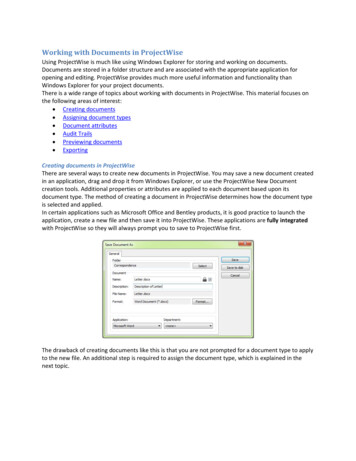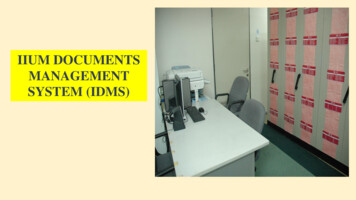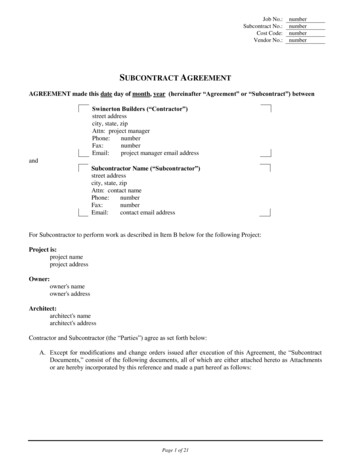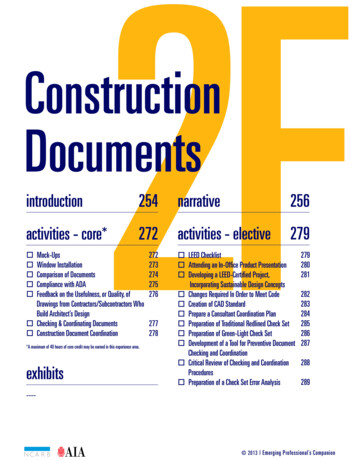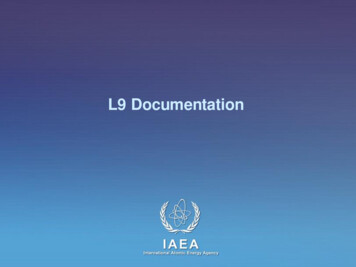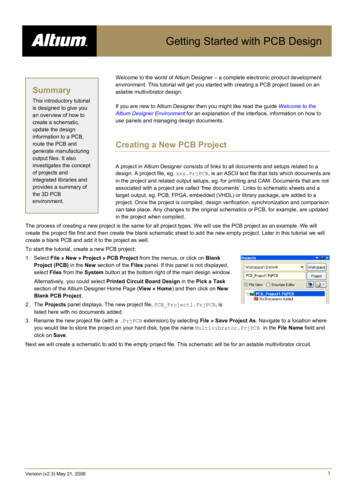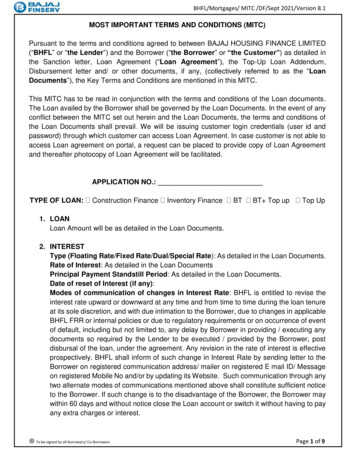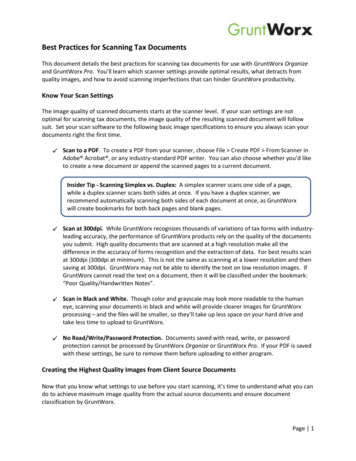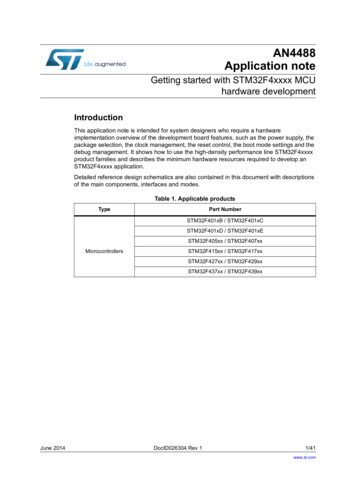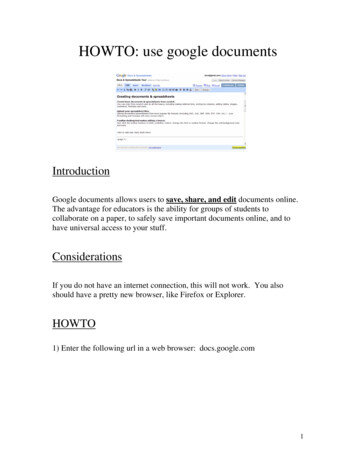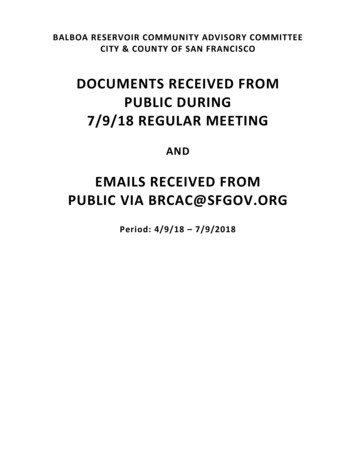
Transcription
BALBOA RESERVOIR COMMUNITY ADVISORY COMMITTEECITY & COUNTY OF SAN FRANCISCODOCUMENTS RECEIVED FROMPUBLIC DURING7/9/18 REGULAR MEETINGANDEMAILS RECEIVED FROMPUBLIC VIA BRCAC@SFGOV.ORGPeriod: 4/9/18 – 7/9/2018
BALBOA RESERVOIR COMMUNITY ADVISORY COMMITTEECITY & COUNTY OF SAN FRANCISCODOCUMENTS RECEIVED FROMPUBLIC DURING7/9/18 REGULAR MEETINGPeriod: 4/9/18 – 7/9/2018
[No Documents Received]
BALBOA RESERVOIR COMMUNITY ADVISORY COMMITTEECITY & COUNTY OF SAN FRANCISCOEMAILS RECEIVED FROMPUBLIC VIA BRCAC@SFGOV.ORGPeriod: 4/9/18 – 7/9/2018
Shanahan, Thomas (ECN)From:Sent:To:Cc:Monday, July 09, 2018 4:00 PMShaw, Jeremy (CPC); Shanahan, Thomas (ECN); BRCAC (ECN)Lesk, Emily (ECN);Subject:role of City Staff / zoningJeremy, BRCAC-Once again, thanks for your response, Jeremy.Several days ago, SF Chronicle had an article about 1550 Evans and the role of City Staff.The Chronicle article regarding proposed housing at 1550 Evans said:Word that the city had been piecing together an alternative plan for 1550 Evans sparked anger and dismay amongBay-view residents, who felt as though officials were working behind closed doors to derail the long-plannedvision for the community center without seeking their contributions or consent.Similar to 1550 Evans, well before the BRCAC and public engagement process was established, theCity was working behind closed doors to set up ducks-in-a row for the Reservoir Project. The ducksin-a-row were set up to delimit the parameters of discussion by the public to facilitate a foregoneconclusion that City officials had already pre-ordained.You indicate that one of the purposes of a PPA would be to evaluate zoning issues. Your responseindicates that evaluation of zoning issues in a PPA is obviated by City Staff working closely with thedeveloper. However, City Staff does not necessarily reflect the public interest. As far as I know, eventhough I know that I had brought up zoning questions in the BRCAC process, City Staff has notseriously discussed zoning issues with the public.Zoning discussion has been inadequate. The Reservoir is currently zoned "P" (public). TheReservoir Project will undoubtedly ask for the elimination of the "P" zoning. The significance of theelimination of "P" zoning is that public land will be privatized. Discussion of the issue of privatizationof public land has never been solicited nor allowed by City Staff.The PUC Reservoir is currently zoned 40-X. The Reservoir Project will undoubtedly also ask forelimination of the 40-X zoning.The Balboa Reservoir City Team consists of PUC, Planning, OEWD--with Planning Dept being thelead agency. How can the Planning Dept objectively conduct environmental review of a developmentwhich it is itself leading?--aj1
Pursuant to Sunshine Ordinance requirements, please provide the following to the public:1. Reservoir Project PPA2. Planning Dept's PPA response/letterThank you in advance for sharing the PPA and Planning Dept's response to the PPA, as well as theEEA, with the community.Sincerely,ajFrom: "Shaw, Jeremy (CPC)" jeremy.shaw@sfgov.org To:"Shanahan, Thomas (ECN)" thomas.shanahan@sfgov.org Sent: Friday, July 6, 2018 5:16 PMSubject: RE: EEA, NOP, NOSHi AJ,We received the environmental application on June 1st and are still reviewing it for acceptance/completion. Since the NOPand scoping meeting cannot be scheduled until the application is accepted, we do not have dates for them yet. I expectthem to be in the fall.You can see content of the developer’s proposal in the April 9th CAC presentation at http://sf-planning.org/brcac . Whenthe application is accepted, it will also be posted online.I agree with your suggestion, we can share these updates with the public at the July 9th CAC meeting.JeremyJEREMY SHAW Senior Planner SF PLANNING 415.575.91353
Shanahan, Thomas (ECN)From:Sent:To:Saturday, July 07, 2018 9:36 AMBRCAC (ECN); Shanahan, Thomas (ECN);Subject:Joe Kirchoferadditional comment for 7/9/2018 BPCAC Transportation meetingBPCAC:A few days ago I had sent you a Written Comment on Transportation that cited a UCB Haas Schoolof Business "Westwook Terrace" study/ proposal.The Written Comment quoted "Key Challenges" from that study proposal. I urge you to examine howthe Reservoir Project has addressed those "Key Challenges" --in particular:2. As the largest student parking area on-campus, preservation of parking capacity onthe Balboa Reservoir is a focal point for both the City College and the local community.3.Due to limited access points and large influx of new residents, traffic impact and flow isa primary concern for the project.The Reservoir Community Partners, LLC's (Avalon-Bridge) Base Plan shows motor vehicle access attwo points: Lee Avenue (Whole Foods exit) and North Street (adjacent to Riordan High). Thisconfirms the Haas Business School study's observation of "limited access points and large influx ofnew residents."Yet the Reservoir Project's solution has been TDM and Residential Permit Parking which is totallydeficient in addressing a "Key Challenge."To refresh your memory, please consider and review the following (from an earlier submissionregarding the Nelson-Nygaard TDM Framework) for your Transportation discussion:The main significance of the TDM Framework is that it functions as a means for theReservoir Project to avoid its responsibility to mitigate its adverse impacts:INHERENT INEQUITY IN THE BALBOA AREA TDM FRAMEWORK:DUMPING THE BALBOA RESERVOIR PROJECT’S RESPONSIBILITY TO MITIGATE ITSADVERSE IMPACTS ONTO ITS VICTIMS4
CEQA principles call for new projects like the Balboa Reservoir Project to mitigate adverseimpacts on the existing setting.Being a public service, City College has CEQA standing as an “environmental factor” that wouldrequire the proposed Reservoir Project to mitigate its adverse impacts.From the very beginning of the Reservoir Project's public engagement process, CCSFstakeholders have complained about the adverse impacts on student enrollment andattendance that would be generated by the Project's eviction of existing student parking.GENESIS OF BALBOA AREA TDM FRAMEWORK STUDYIn order to assuage community concerns regarding parking and traffic, the Reservoir Projectinitiated the Balboa Area TDM Study.People in the community were expecting the study to be an all-around and objective analysis oftransportation issues. What people in the community did not realize was that the TDM Study’sgeneral conclusions had already been pre-ordained.The Balboa Area TDM Study had been given its marching orders:“The Planning Department and SFMTA are proposing a Transportation Demand Management (TDM) study incoordination with CCSF Ocean Campus to reduce single-occupant vehicle trips by college staff, faculty, students, andneighborhood residents.”WILLFUL DISREGARD FOR HARD DATAThe City Agencies have managed the Reservoir Project in a manner similar to how the Iraq Warhad been promoted. Just like the Iraq War in which, according to British Intelligence’s DowningStreet Memo, “ the intelligence and facts were being fixed around the policy”, therecommendations and conclusions of the Nelson-Nygaard study have been fixed around thepre-determined TDM policy.The Balboa Area TDM Framework has been fixed with willful disregard for the hard datafrom surveys that would refute the pre-determined TDM dogma.WILLFUL EXCLUSION OF COMPREHENSIVE PARKING ASSESSMENTSunshine Ordinance documents reveal the following:In 2014, the AECOM Transportation Analyst had proposed performing a comprehensive supply& demand assessment for all on-street and off-street parking in the neighboringvicinities. Jeremy Shaw of the Planning Dept put a stop to AECOM’s proposal to perform thiscomprehensive assessment.Instead, in a 2014 email to the AECOM Transportation Analyst, Planning Dept told AECOM toconfine their study to the Reservoir parking lots alone:“ .edits made in the attached word document reflect the current thinking in SF transportation analysis.“Comment [JS4]: We’d recommend just looking at the [Balboa Reservoir parking lots--aj] parking lots. ‐‐‐ Off‐siteparking analysis is nice to have. But really we want to focus the effort on what will drive the on‐site design and whatkind of trips that design will generate – rather than worry about off‐site impacts and mitigations ”So from the very beginning, starting with the AECOM Existing Conditions’ TransportationAnalysis, a full and objective assessment and analysis had already been stopped in its tracks bythe Reservoir Project Staff.5
“THE CURRENT THINKING IN SF TRANSPORTATION ANALYSIS”What was--and is--the “current thinking?” .The thinking is: Don’t “worry about offsite impacts and mitigations.”MANIPULATION AND BIAS IN CITY’S SURVEY OF CITY COLLEGE PARKINGThe Reservoir Project's data collection was deliberately skewed to minimize apparent parkingdemand at City College. It did this by collecting PM data from 10 pm to 12:30 am when noclasses are in session. From the Reservoir Project's Balboa Area TDM Existing ConditionsReport: "The surveys were conducted during two periods; midday, between 10:00 AM to 4:00 PM; and late evening, between 10:00 PM to12:30 AM."Why would a parking survey be performed between 10pm and 12:30am when any fool could tellyou that the CCSF parking lot would be empty?DELIBERATELY OBSCURED: CONTEXT OF RESERVOIR BEING A NEW PROJECTThe TDM Study was a response to community concerns about transportation issues that wouldbe generated by the new Reservoir Project that would impact the existing setting of City Collegeand the surrounding neighborhoods.The TDM Framework obscures this context by placing the new Reservoir Project on an equalfooting with City College and the surrounding neighborhoods. The Balboa Area TDMFramework delineates three sub-areas: 1) City College Ocean Campus, 2) Balboa Reservoir ,and 3) Balboa Area neighborhoods.The TDM Framework fails to acknowledge the fact that the Balboa Reservoir sub-area, as anew proposed project, is responsible for mitigation of its adverse impacts. Instead, the TDMFramework presents the Reservoir Project as a fact-on-the-ground with importance equal to--ifnot greater than--City College and the neighborhoods.THROWN OVERBOARD: STUDENT INTERESTS OF ACCESS TO EDUCATIONBy putting the Reservoir Project on equal footing with City College and the neighborhoods, theReservoir Project has been, with a sleight-of-hand, absolved of its CEQA responsibility tomitigate its adverse impacts on the existing setting.Instead, mitigation has been dumped onto the Reservoir Project’s victims. Instead of theReservoir Project being held responsible for providing replacement parking for students, CityCollege’s FMP has had to respond by proposing new parking structures on SFCCDproperty .but with no realistic funding sources for such structures necessitated by eviction ofstudent parking.INEQUITY IN BALBOA AREA TDM FRAMEWORKPage 18 of the TDM Framework has a section entitled "Parking availability." The section bringsup Balboa Park Station and City College as mahor trip generators. The section says thatconcerns have been expressed about parking during class times. Yet this "Parkingavailability" section pointedly avoids any mention whatsover of the impact of 2,200 newresidents in a new residential project projected to contain about 550 parking spaces!On page 25, the TDM Framework has set up car-use reduction targets for the City Collegestudents and employees, and for the new Reservoir residents. It has also proposed ResidentialPermit Parking for the neighborhoods: The target for City College is 20%.6
o According to Figure 4 “Current and Recommended Mode Split, CCSF’s OceanCampus”, the TDM Framework calls for student drivers be cut back from 35% to20% (a reduction of 43%).o The TDM Framework calls for CCSF employee drivers to be cut back from45% to 20% (a reduction of 56%). The TDM Framework sets an initial car use target for new Balboa Reservoir residentsto be 60%.o In comparison, CCSF student car use is already down to 35%and CCSFemployee car use is already down to 45%. Further cuts to 20% mean that CCSFstudents and employees are being expected to sacrifice access to CityCollege in order to benefit new Reservoir residents. The TDM Framework has called for neighborhood residents to initiate ResidentialPermit Parking to mitigate spillover parking generated by students who will no longer beable to park in the Reservoir and to discourage new Reservoir residents to park in thesurrounding neighborhoods.o This is another shameless example of dumping mitigation responsibilities ontothe victims of the Reservoir Project instead of the new Project taking responsibilityfor its own adverse impacts.OVERARCHING GOALSThe TDM Framework sets up 4 overarching goals:1.2.3.4.Reduce vehicle-miles traveledReduce auto tripsReduce traffic congestionReduce transportation costs to preserve housing affordabilityFALSE EQUIVALENCE: REDUCING CAR USE vs. STUDENT ACCESSConspicuously missing from the list of overarching goals is: ENSURING STUDENT ACCESSTO EDUCATION. Other than providing Orwellian vacuous and perfunctory talk about “theimportance of accessible education and striv[ing] to establish equitable transportationchoices ” the TDM Framework proffers no realistic or effective solution to the priorities shownto be important to CCSF stakeholders in data collected in the CCSF Transportation Survey.Hard data from the survey shows that “Reducing Travel Time” and “Arriving on Time” areoverwhelmingly the most important considerations in choosing transportation mode.CONFLATING MEANS WITH ENDS: THE OVERARCHING IMPORTANCE OF THEDESTINATIONA fundamental flaw of the TDM Framework is that it only treats the issue of reducing car usagein isolation.It should not take a lot of smarts to realize that transportation is an issue only when there’s adestination involved. Lacking a desired destination, transportation and parking are a nonissues.The TDM Framework fails to recognize the fact that transportation is just a way to get to adesired destination. Instead, it dogmatically asserts that parking in and of itself generatestraffic.7
TDM FRAMEWORK: SPEAR-CARRIER AND PROPAGANDA FOR BALBOA RESERVOIRPROJECTThe Nelson-Nygaard TDM documents serve as spearhead documents to advocate for theinterests of the Balboa Reservoir Project, NOT for the interests of City College stakeholders orfor the neighborhoods.The main significance of the TDM Framework is that it functions as a means for theReservoir Project to avoid its responsibility to mitigate its adverse impacts.8
Shanahan, Thomas (ECN)From:Sent:To:Subject:Aaron GoodmanSaturday, July 07, 2018 9:18 AMBRCAC (ECN)Balboa Reservoir CAC Meeting Monday July 9th 6:00pm - CommentsBalboa Reservoir CAC MembersI am unable to attend to listen and provide input on the Transportation Updates, and input on the CCSF planningas well.I do believe my thoughts and concerns have been raised sincerely on the issues of long-term planning for Oceanave and the adjacency to the Balboa Park Station. But to relay this and to ensure that transit long-term planningis not only thought of but supported, planned for and financed, it is critical to get projects on the agenda anddesigned in full to achieve the system changes to relieve traffic and congestion along Ocean and around themajor connectors between districts.1) The balboa reservoir project should support and improve direct connection via pedestrian and bike, or shuttleto Balboa Park Station.2) The CCSF future proposal(s) should include a "high-line" solution on the south-side of campus along oceanusing topography and possibly the elimination of the existing cross-over pedestrian bridge with a better welldesigned "high-line" route that brings people from Phelan down across the freeway and into the BART stationnorth entry ramp. Connection can be provided on the SE corner of the CCSF site, with a direct "off-ramp" intoan east side garage. The land is there and housing and new buildings could be infilled along the eastern andsouth-eastern segment of the site. The garage proposal at phelan only adds traffic to the west-side and impedesthe corner entry to the Balboa Reservoir. A better designed, housing and retail area should be considered nearthe PAEC building.3) Pedestrian bridges along the eastern edge of CCSF and the freeway need improvements physically andstructurally, this includes safety, lighting and aesthetics to improve walking to Ocean from the mission andvice-versa.4) Extension of the Ocean Ave designs and merging of the merchant areas in the mission and ocean to improvethe walking zones between shopping areas will improve pedestrian and bike routes, by lessening auto use.5) Do not let Caltrans ignore the freeway zones and the impacts of lacking changes in public infrastructure.Demand that they improve the off-ramps to allow for a direct off-ramp into a parking garage at CCSF to lessenauto impacts on Ocean ave.6) look seriously at micro-shuttle bus systems that could bring people across the reservoir site to CCSF and overto Balboa Park station as a micro-linked system. (See Germany auto-micro-bus concepts) and look at how theseloops around the reservoir and ccsf can perform a figure "8" loop down and past the Balboa Park Station.7) Request that CCSF be adventurous in mind on the designs of future buildings, current "parti" designs for theSW corner of the site are "mundane" and do not indicate a more adventurous design concept. Make sure thatthey are pressured on the issues of good modern design concepts that link/loop and connect with and usingtopography on the site. The focus on the western edge of campus leaves other areas lacking in vision.9
Thank you for reading and sending these comments to the appropriate parties involved in the BRCACPlanning.SincerelyAaron Goodman D1110
Shanahan, Thomas (ECN)From:Sent:To:ajMonday, July 02, 2018 11:27 PMBRCAC (ECN); Shanahan, Thomas (ECN);Cc:Subject:Yee, Norman (BOS); Low, Jen (BOS); Maybaum, Erica (BOS); Board of Supervisors, (BOS)COMMENT ON TRANSPORTATION FOR 2018-7-9 BR CAC MEETINGCOMMENT ON TRANSPORTATION FOR 2018-7-9 BR CAC MEETINGMuch of the City Team’s strategy to promote the Reservoir Project is derived from a 2012study/development proposal sponsored by NAIOP (National Association of Industrial and OfficeProperties). Much of Avalon-Bridge’s Base Plan for the Reservoir is also derived from this NAIOPsponsored study/proposal.The study/development proposal was done as a project by UC Berkeley’s Haas School of Businessstudents. The development proposal was part of a competition for a “Golden Shovel” award.The development proposal was entitled “Westwood Terrace in Balboa Park.”FRAMING/ MARKETING DECEPTIVE ADVERTISINGThe “Westwood Terrace” development proposal offered a marketing/PR approach: Given the depth of anti-development sentiment related to the site and thecoordination of the local neighborhood groups, it is vital that the project be framed as asolution to current problems and an asset to the local community.The Reservoir Project has been skillfully framed/marketed as “50% affordable housing”. But what arethe facts?The truth of the matter is that that the Reservoir Project’s own Development Overview provides onlyfor: 50% (550 units) market-rate; 18% (198 units) low-income (80% AMI-- 66,300) 15% (165 units) moderate-income (120% AMI-- 99,500) 17% (187 units) HYPOTHETICAL (not funded or planned by the private developer)“additional affordable” middle-income (150% AMI-- 124,350)SINCE RESERVOIR COMMUNITY PARTNERS, LLC HAS NO RESPONSIBILITY TO ACTUALIZETHE 17% “ADDITIONAL AFFORDABLE” (for individuals of up to 124,350 annual income perMayor’s Office of Housing & Community Development’s 4/1/2018 max income table), the marketinghype of “50% affordable” is a lie.KEY CHALLENGES: PARKING & TRAFFICThe “Westwood Terrace” development proposal identified “Key Challenges” for the proposeddevelopment:11
1. The Site will need to overcome a difficult entitlement process. In order to maximizethe value of this unique Site, rezoning and increased density will be required. Obtainingthese entitlements in the City of San Francisco can be a drawn-out process spanningmultiple years.2. As the largest student parking area on-campus, preservation of parking capacity onthe Balboa Reservoir is a focal point for both the City College and the local community.3. Due to limited access points and large influx of new residents, traffic impact and flowis a primary concern for the project.4. Development of the Site will require significant infrastructure costsPoints #2 and #3 of “Key Challenges” reflect the real world. Yet throughout the City Team’s publicengagement process, the City Team has sought to ignore the real world and has downplayed theadverse impacts of the Project on parking and traffic.The City Team’s solution consists of TDM (Transportation Demand Management) and ResidentialPermit Parking. The TDM and RPP solutions fundamentally dump the burden and responsibility tomitigate adverse traffic and parking impacts from the new Reservoir Project onto existing City Collegeand neighborhood stakeholders.Furthermore, the biggest contributing factor in demand would be the influx of 2,200 new Reservoirresidents—something which Key Challenge #3, unlike the City Team’s Development Parameters,acknowledges.The 2012 “Westwood Terrace” development proposal, unlike the City Team’s TDM solution, offered amore real-world solution to Key Challenges #2 and #3.The “Westwood Terrrace” proposal’s “Core Programmatic Concepts” to address key challenges ofparking and transportation included these more sensible ideas (compared to the City Team’sTDM/RPP solution):2. Maintain majority of student parking on-site; a major consideration of both CCSFand the surrounding neighborhood group. Current Site layout allows for developer tobuild below the natural grade without incurring significant excavation costs.3. Inclusion of “car-free” Student Housing units allows Site to reach revenue andabsorption potential while minimizing traffic impacts highlighted as major concern due toSite’s limited ingress/egress points.CITY COLLEGEThe “Westwood Terrace” proposal included a section on “Primary Neighborhood Stakeholders”,among which was City College.The “Westwood Terrace” development proposal’s section on City College stated:Conversations with City College representatives suggest that the predominant concern that theschool has for the site pertain to reduction in parking. The Reservoir is the school’s primaryparking facility and with over 32% of students and 63% of faculty driving to school, anysubstantial reduction of parking would create serious problems for the campus. If the parkingissue can be resolved, the City College would be likely to support on-site development that12
provides student or faculty housing. To-date, the City College has not been an activeadvocate or opponent of nearby development but we believe that dynamic is likely to changeshould new development be proposed that substantially impacts the school’s supply ofparking.It should be noted that the SFCCD authorities have appointed and re-appointed a Program Managerto represent City College interests vis a vis the Reservoir Project. It should also be noted that theProgram Manager is a Principal of Curtis Development who was co-developer in the RelatedCalifornia Proposal for the Reservoir. Because of this background, it may be difficult for the ProgramManager to unequivocally advocate for grassroots CCSF stakeholders.The grassroots CCSF stakeholders’ position can only be for full mitigation of loss of studentparking. The costs of any and all replacement parking necessitated by the loss of parking in theReservoir must be borne by Avalon-Bridge and not by SFCCD.This written comment on Transportation repeats what has been brought up constantly by many atBRCAC meetings and in written submissions over the past several years. The only thing new here isthe citation of content from the NAIOP Golden Shovel proposal.--aj7/2/201813
Shanahan, Thomas , June 19, 2018 8:54 PMBRCAC (ECN); Hood, Donna (PUC); Secretary,Commissions (CPC); Board of Supervisors, (BOS)Yee, Norman (BOS); Low, Jen (BOS); Maybaum, Erica (BOS); Choy, Jarlene (BOS); RafaelMandelmanWritten comment on Reservoir Open Space2018-6-19 WRITTEN COMMENT ON BALBOA RESERVOIR OPEN SPACE.pdf;2017-10-25 updated version-- UNADDRESSED FLAWS IN BALBOA RESERVOIRPROJECT.docxPUC, Planning Commission, Board of Supervisors, BRCAC, Reservoir Community Partners, LLC:Attached is comment on Balboa Reservoir Open Space, solicited by Reservoir Community Partners,LLC for 6/23/2018 meeting.14
WRITTEN COMMENT ON BALBOA RESERVOIR OPEN SPACEThe fundamental issue of privatization of public assets has never been addressed throughout theReservoir Project’s public engagement process.The PUC Reservoir parcel 3180 is zoned as a P (Public) District according to the Planning Code. The useof this “P” parcel for private ownership is not allowed under the Planning Code.The Planning Code further requires that:If the accessory nonpublic use is located on a lot with an OS Height and Bulk designationper Section 290 of this Code, it shall occupy a de minimis amount of space so that it doesnot detract from the lot's principal or exclusive purpose as open space. In no case mayaccessory nonpublic uses occupy more than 1/3 of the total lot area occupied by theprinciple use;Also, being adjacent to the Westwood Park Residential Character District, the Planning Codefurthermore requires that:If the accessory nonpublic use is located within 1/4 mile of a Restricted Use Subdistrictlisted in Article 2 or 7, then no use prohibited in such Subdistrict may be permitted as anaccessory nonpublic use;I expect that the Reservoir Project intends to rezone the PUC Reservoir from public “P” zoning and forremoval of the 40-X height limit zoning to a substantially higher bulk-height zoning. The PlanningCommission and Board of Supervisors should not allow this. Planning Commission and Board ofSupervisors should not be facilitating the privatization of public property.The Balboa Park Station Area Plan has been used to justify the development of the Reservoir byReservoir Community Partner, LLC. However, the citation of the BPS Area Plan has been selective anddistorted. From my submission entitled “Unaddressed Flaws in Balboa Reservoir Project” (attached), Ihad written the following which relates to the BPS Area Plan’s call to consider Housing and Open Space:10. Best use of PUC Reservoir:Under Objective 1.4 of the Balboa Park Station Area Plan, Policy 1.3.2 [sic] states "POLICY 1.3.2Develop the west basin of the reservoir [for] the greatest benefit of the city as a whole as well asfor the surrounding neighborhoods."City/Mayor simply declared by fiat that it would be used for housing (without mandatingcompliance with the intent of State and City Public Lands laws regarding legally-definedAffordable Housing).
using the west basin for educational purposes would be the"greatest benefit."11. Balboa Station Area Plan does not mandate housing at ReservoirProponents of the Reservoir Project refer to the Balboa Park Station Area Plan as calling forhousing on the Reservoir. This is inaccurate. The BPS Area Plan actually used the term"consider." It called for housing to be considered. It was not a mandate. In addition to housing,there was something else that the BPS Area Plan asked to be considered: OPEN SPACE.The BPS Area Plan contains several elements, among which are the Housing Element and theOpen Space Element.The Open Space Element of the BPS Area Plan includes discussion of the western Reservoir asopen space and includes this map, yet this section of the BPS Area Plan has been ignored.And then again, on a broader perspective, the BPS Area Plan has asked that the "best use" beconsidered for the Reservoir. Instead of "best use" or "open space" as presented by the BPSArea Plan, the City jumped directly to housing as the sole consideration.I took an Anthropology class that was taught on the 3rd floor of the Science Building in Fall 2017. Fromthe classroom, we were able to take in the view of the Pacific Ocean out to the Farallon Islands. Thisview will be lost with the high-density Reservoir development.
Avalon-Bridge’s plan to offer 4 acres of open space out of the Reservoir’s 17.4 fails to address theReservoir Project’s impact on the existing neighborhood character, context and setting.CALL FOR RESERVOIR COMMUNITY PARTNERS,LLC, OEWD, PLANNING DEPT, and PUC TO DESIST IN THEMISREPRENTATION OF “50% AFFORDABLE”The Reservoir Project has been able to gain traction because of the deceptive marketing of “50%affordable.” The fact is that the Reservoir Project’s own Development Overview provides only for: 50% (550 units) market-rate;18% (198 units) low-income (80% AMI-- 64,500)15% (165 units) moderate-income (120% AMI-- 97,000)HYPOTHETICAL (not funded or planned by the private developer) “additional affordable”middle-income (150 AMI-- 121,000)SINCE RESERVOIR COMMUNITY PARTNERS, LLC HAS NO RESPONSIBILITY TO ACTUALIZE THE 17%“ADDITIONAL AFFORDABLE” (for those of up to 121,000 annual income), the deceptivemisrepresentation of “50% affordable” needs to be corrected. “50% affordable” is fundamentallydeceptive advertising.Submitted by:Alvin JaSunnyside resident, City College stakeholderJune 19, 2018
UNADDRESSED FLAWS IN BALBOA RESERVOIR PROJECT (updated 10-25-2017)The Balboa Reservoir Project has been presented to the community essentially as a done-deal. It hasbeen justified by referencing the Balboa Park Station Area Plan and the Public Land for Housing Program.However, there has been no fact or evidence-based analysis of the assumptions and premises involvedin the Reservoir Project’s so-called affordable housing. The Project has been framed as an affordablehousing effort; it
o According to Figure 4 "Current and Recommended Mode Split, CCSF's Ocean Campus", the TDM Framework calls for student drivers be cut back from 35% to 20% (a reduction of 43%). o The TDM Framework calls for CCSF employee drivers to be cut back from 45% to 20% (a reduction of 56%).
